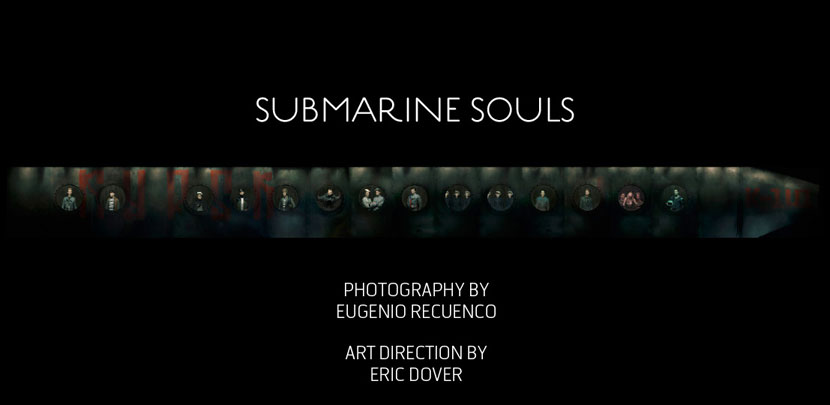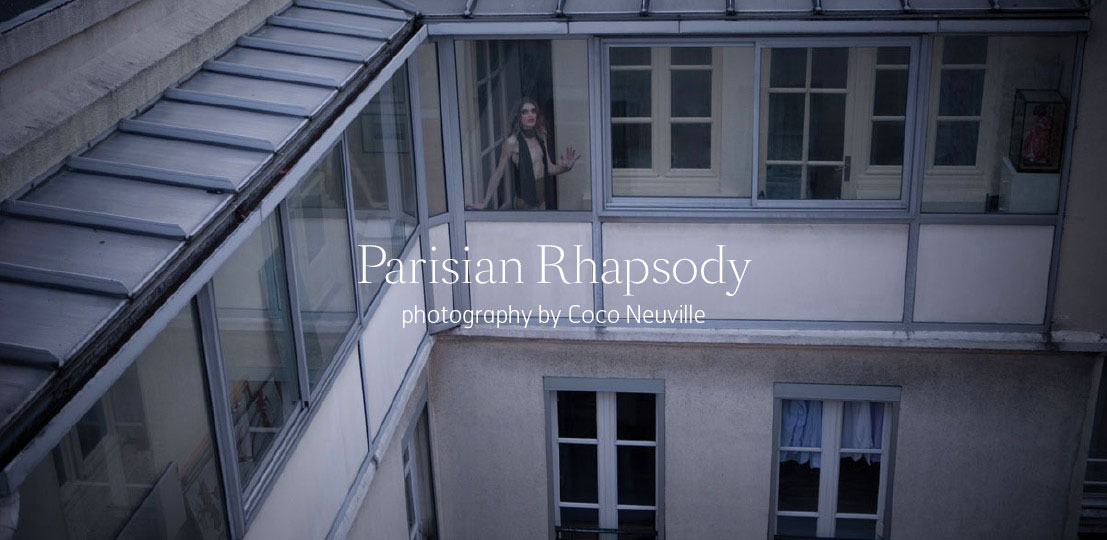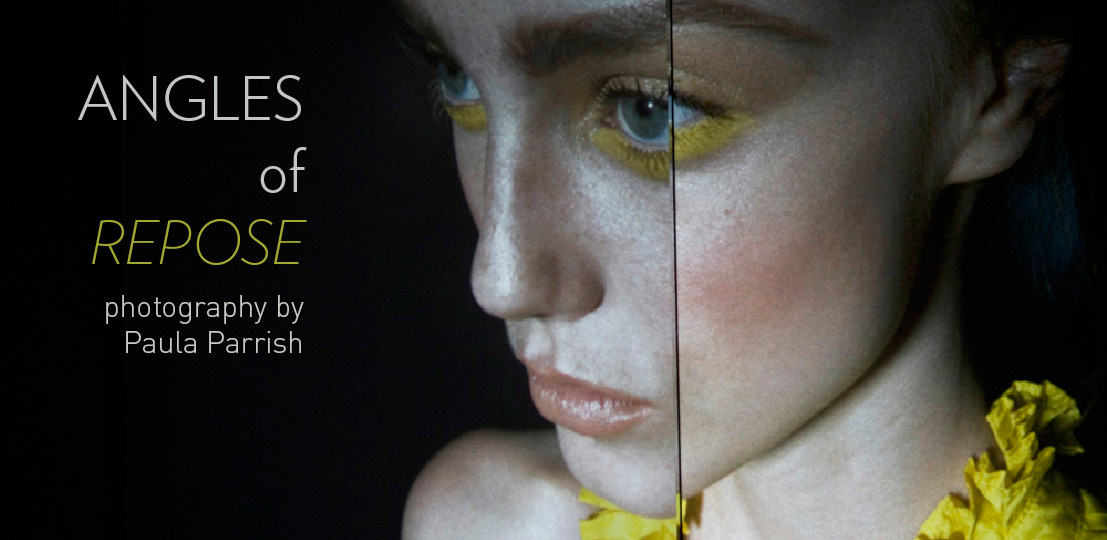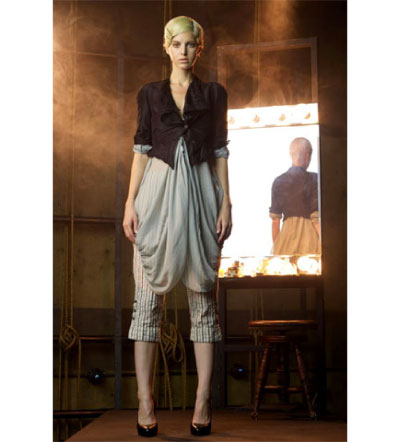
Lookbook photography by Alex Antich

New York-based designer Gary Graham’s ready-to-wear line for Spring 2010 is accessible, modern, and flexible, and built for a similar lifestyle. The collection of knit tank dresses, leather skirts and leggings, and draped dresses are mostly simple and chic; they’re embellished basics in muted colors that encourage a mix-and-match mentality. Designing for over ten years, Graham is not terribly daring, but accomplishes the rare task of remaining relevant. Graham’s high hemlines are youthful rather than risky; the relaxed fits and possibilities for layering help the pieces maintain a cool modesty and trend-defying longevity. An undertone of minimal deconstructionism and a simplified utilitarian vibe are reminiscent of Alexander Wang’s favorite silhouettes (soft draping and textures, menswear elements in oversize pieces made of shirting, form-fitting leather, flowy silks). But among all the army green and tomboyish nuances, Graham also makes sure the collection is a little soft: the stars for Spring 2010 include feminine chiffon slip dresses and luminous silk vests. Graham’s petticoat-like dresses round out the spring wardrobe and beg to be accessorized with skinny belts and ankle boots. A good look at Graham’s textural details hint at his traditional training in textiles: varying waistlines and ruffles seem subtly Victorian-inspired. Other airy details give a vintage feel that should improve with wear.
(more…)
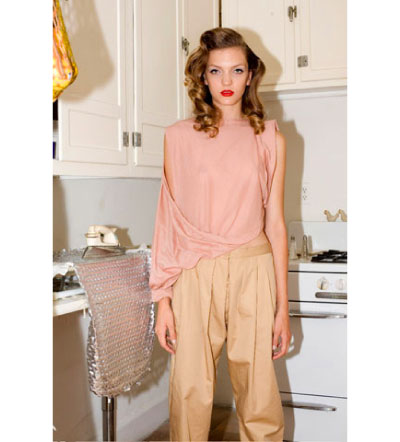
Photography by Steven Rose for Spring / Summer 2010

Tom Scott wants you to have a casual and comfortable spring. His ready-to-wear collection is full of cottons and drapery that probably just look better as they get worn in. The Ralph Lauren alum has been making strides ever since winning an Ecco Domani award in 2007. While lately he’s catapulting his brand into the future (in September the first Tom Scott store opened in the Lower East Side, and he’s launching a collection of archived designs this year), Scott looked to the past to inspire his Spring 2010 collection. Influenced by “some of the old-fashioned things you can find in your grandmother’s house”, the knitwear designer translated curtains, bed linens, even hair nets, into clothing. The details of striped bedsheets and ruffled textiles appear in sweatshirts; the visage of sheer drapes emerges in delicate tops and holey sweaters. The pieces even bear names like “Twisted Curtain Top” and “Valance Sleeve Cardigan”. In this collection Scott refreshes old-fashioned elements without leaning on a retro sensibility. He relies on the accessibility of comfort; the touchable fabrics in muted colors and slouchy-not-sloppy designs help establish a mood and lifestyle for the brand without departing from reality. Even the presentation for the collection was inviting. At the Chelsea Hotel Scott orchestrated a tableau of models playing house and lounging in a living dollhouse. Scott has declined to follow trends and has just given us clothes to truly live in.
(more…)
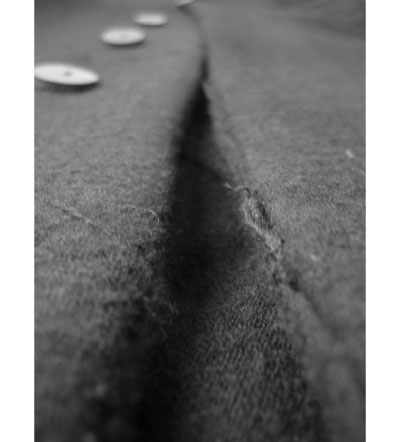

Sometimes we forget the meaning of the most common words. For example, ask yourself, “What is design?” The answer may not be as easy as you think. And maybe there is no single answer, but here is one: design is a carefully thought out process of manifesting ideas into physical form. Designers who do this are worthy of the name. Luca Laurini, the creator behind Label Under Construction (LUC), a niche clothing brand, is certainly one of them. Every garment designed by Laurini and manufactured by this obscure Italian brand is so carefully thought out that sometimes the level of detail borders on the obsessive. Despite being sold in exclusive boutiques around the world, Laurini is equally committed to keeping a low profile and avoiding the fashion media brouhaha. This is the first ever interview he has granted. (Don’t bother googling, there is no website.)
I caught up with Laurini in LUC’s carefully hidden showroom in Le Marais. Dressed in his own clothes, Laurini was milling around the big white space where his clothes hung by their metal tags from one continuous spool of wire screwed into the wall along the room’s perimeter. He was helping buyers with their orders, patiently answering their questions. Laurini has a slim build and his bearded face is warm and inviting. He looks every bit the artisan that he is.
The essence of Label Under Construction is its intricate knitwear.
(more…)
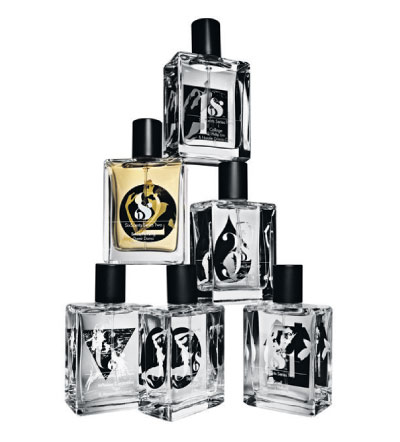

It’s no secret that the fragrance market is oversaturated, with about two hundred new perfumes launching each year. A perfume is the cheapest way to buy into a brand, and therefore a highly lucrative business. Everyone, be it a jewelry company or a newly minted Paris Hilton clone, wants a piece of the $15 billion-a-year pie.
Kaya Sorhaindo, the man behind the fragrance project Six Scents, wanted to do something different. He came up with an idea: take six young, promising fashion designers and pair them with expert perfumers in order to create unique scents manufactured in small amounts. Sorhaindo discussed this idea with Symrise, a German scent laboratory, and thus Six Scents Series One was born. Symrise provided the perfumers and Joseph Quartana, the co-owner of a SoHo boutique Seven, chose the designers. “We tried to pick designers without previous experience with fragrances but with a strong vision and their own esthetic,” Sorhaindo told me in a recent interview. The line up for Series One includes such names as Bernard Willhelm and Gareth Pugh. The current collection, Series Two, features Damir Doma and Henrik Vibksov, among others.
Cutting out the middlemen was essential to Sorhaindo. “It’s a one-on-one experience between the designer and the perfumer,” he said. “Once a frustrated perfumer who was collaborating with Bernhard Willhelm called me: ‘Bernhard wants a perfume that smells like air and water. I can’t create a fragrance that doesn’t smell like anything.’
(more…)
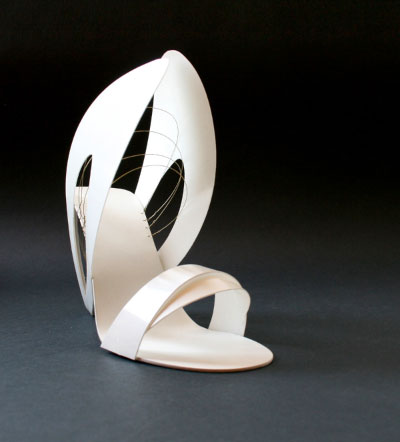

Coco Chanel was quoted as saying, “Fashion is architecture: it is a matter of proportions.” Sarajevo design student Tea Petrovic seems to have taken Coco’s statement to heart; for her graduating project, Petrovic designed a startlingly original collection of shoes based on the designs of the greatly influential Spanish architect Santiago Calatrava and the works of the late Russian Constructivist sculptor Naum Gabo. But Petrovic quotes another fashion designer in her statement, writing, “Bernard Figueroa once said: ‘There is so much space between a woman’s heel and the floor that one can use, and that is exactly what I tried to accomplish … using this space as much as possible.”
Discarding the fashion designer’s usual considerations of function and comfort, Petrovic focuses instead on the shoe as a pure geometric form, “rich in freedom and artistic expression”. She chose Gabo and Calatrava for their focus on figures “inspired mostly by nature, space, geometric shapes, and mathematical principles”.
The heel, specifically, is Petrovic’s focal point. To her, heels “are like supporting poles, constructive elements which carry the whole creative process”. Petrovic created the 3D heel shapes by multiplying, overlapping, and rotating 2D surfaces. The result is a series of exquisitely constructed sculptural works.
(more…)

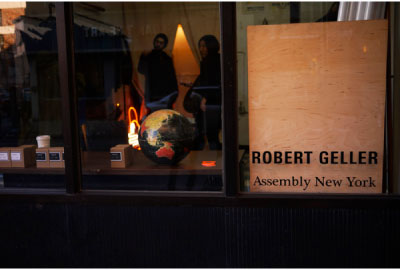


These days Robert Geller, a New York-based menswear designer, is busier than ever, which is just the way he likes it. Besides his successful eponymous line and a collaboration with Levi’s, Geller is launching a new retail venture, called Key Shop. The temporary store, a partnership between Geller and Greg Armas, the owner of the eclectic Lower East Side boutique Assembly, will feature a carefully edited selection of Geller’s products, many exclusive to the store.
Geller has quietly become a fashion fixture of the downtown scene, his slim and pale dandy aesthetic fitting well with skinny dudes of unspecified occupations that roam the streets below Houston and well east of Broadway. “I feel that the Lower East side is where the Robert Geller guy likes to be,” wrote Geller in an email message. “The area has a lot of stores and restaurants popping up, and is still developing nicely. The guys (and girls) there get our aesthetic and will understand the store. I feel like it is the most exciting area of New York right now.”
So, if you want your key (get it?!) Geller items, like a poncho made of cupro and cotton and suede ankle boots, they will be waiting for you at 129 Rivington St., but only until April 15, when the temporary shop will close its doors.
(more…)
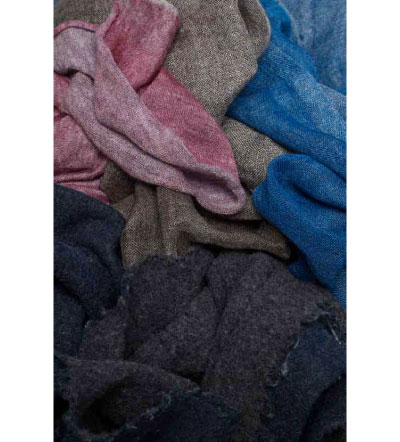

Ever wanted to touch a cloud? Now you can. Because that’s what a Faliero Sarti scarf feels like in your hand. For Monica Sarti, the head designer, the tactile experience is of paramount importance – her company’s most popular fabric is a cashmere/silk blend that infuses the scarves with extraordinary softness.
L’Accessorio Faliero Sarti was founded in 1949 in Tuscany, Italy. It started out as a fabrics house, supplying the newly reborn Italian clothing industry with high quality textiles from its mill. As its reputation grew, so did the list of their clients, which now includes Chanel and Donna Karan.
But Monica Sarti wanted to take the company further than a mere textile manufacturer. Making accessories seemed like a first logical step, since Sarti already possessed extensive expertise in fabrics. Nevertheless, she wanted to push her obsession with manipulating the yarn further. I caught up with co-owner Federico Sarti at Pitti Uomo in Florence to discuss their fabric choices and methods of production. “We are famous of course for using traditional fabrics like cashmere, wool, and modal,” said he, “but we are now also experimenting with more innovative materials such as protein and bamboo.”
(more…)





 Facebook
Facebook Permalink
Permalink Digg
Digg Reddit
Reddit LinkedIn
LinkedIn StumbleUpon
StumbleUpon Tumblr
Tumblr


